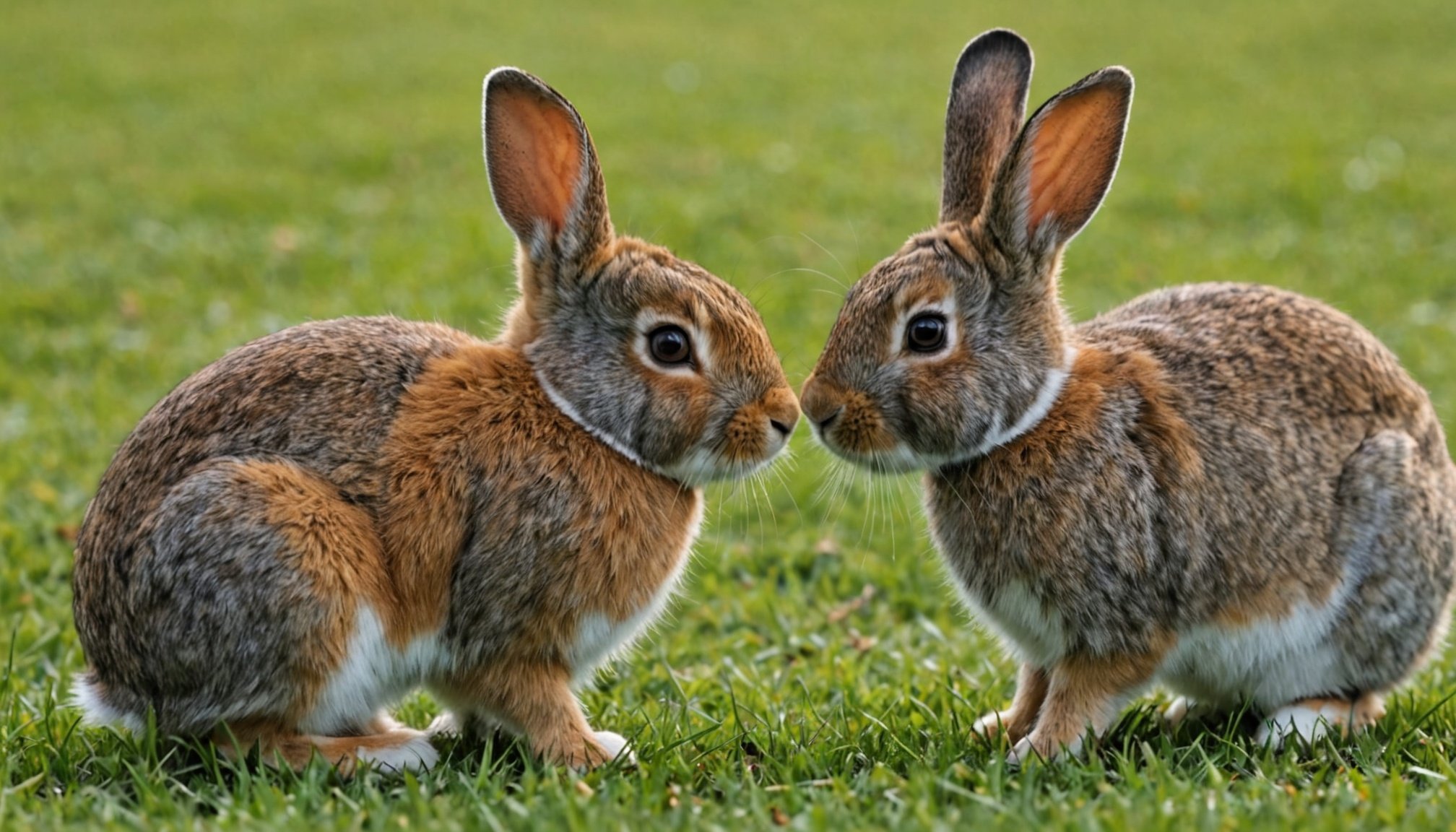Ultimate Guide to Socializing Your New Rabbit: Top Strategies for a Happy Bond
Understanding Your Rabbit’s Social Needs
When you bring a new rabbit into your home, it’s essential to understand that these creatures are inherently social. Rabbits are herd animals that, in the wild, live in large groups and form strong bonds with each other. This social nature is crucial to their emotional and psychological well-being[5].
To create a happy and healthy environment for your rabbit, you need to replicate this social interaction. Here are some key points to consider:
In parallel : Top Strategies to Soothe Your Dog During Fireworks: Effective Calming Techniques Revealed
- Provide Adequate Space: Rabbits need room to move around, stretch, and exercise. A minimum enclosure of a 4×4 exercise pen is recommended for 1-2 rabbits, but larger spaces are always better, especially for giant breeds. This space should include a litter box, toys, and food dishes[1].
- Social Interaction: Spend quality time with your rabbit. This can be as simple as sitting near them, offering gentle pets and treats, and engaging in quiet activities together. This helps build trust and strengthens your bond with your pet[3].
Creating a Safe and Engaging Environment
Your home needs to be rabbit-proofed to ensure both your belongings and your rabbit’s safety. Here are some tips to create an engaging and safe environment:
Bunny-Proofing Your Home
- Secure Wires and Cords: Rabbits love to chew, so make sure all wires and cords are out of reach or secured.
- Protect Furniture: Use baby gates or barriers to block access to areas you don’t want your rabbit to enter.
- Provide Hiding Places: Rabbits need places to hide and feel secure, such as boxes or small enclosures with a roof over their head[1].
Toys and Stimulation
- Rotate Toys: Keep your rabbit engaged by rotating toys regularly. This prevents boredom and keeps them stimulated.
- Interactive Toys: Use toys that challenge your rabbit, such as puzzle toys filled with hay or treats.
- Outdoor Time: Ensure your rabbit gets enough outdoor time in a safe, enclosed area. This can be a fenced garden or a supervised outdoor playpen[1].
Bonding Rabbits: A Delicate Process
If you’re considering introducing a new rabbit to your existing pet, bonding them is a process that requires patience and careful planning.
Also to read : Top Safe Chew Toys for Soothing Teething Puppies: A Comprehensive Guide
Why Bonding is Important
- Natural Behavior: Rabbits are designed to live in groups, so having a companion can significantly improve their mental and emotional health[5].
- Reducing Loneliness: A bonded pair can keep each other company, reducing the likelihood of depression and loneliness.
How to Bond Rabbits
- Neutral Ground: Introduce the rabbits in a neutral area where neither feels territorial. This could be a new room or a playpen that neither rabbit has used before.
- Gradual Introduction: Start by keeping the rabbits separated but allowing them to see and smell each other. Gradually increase their interaction time under close supervision.
- Monitor Behavior: Watch for signs of aggression or stress. If things go wrong, separate them immediately and start the process again from the beginning[5].
Coexisting with Other Pets
If you have other pets in the house, introducing a new rabbit requires careful consideration to ensure everyone gets along.
Dogs and Rabbits
- Training is Key: Ensure your dog is well-trained and can obey basic commands like “sit-stay” or “down-stay.” This helps in managing interactions between the dog and the rabbit[2].
- Leashed Introductions: When introducing the dog to the rabbit, keep the dog on a leash with some slack. This allows the dog to sniff the rabbit without feeling restrained or aggressive.
- Supervised Interactions: Always supervise interactions between dogs and rabbits, especially in the early stages. If the dog shows any signs of aggression or excitement, intervene immediately[2].
Cats and Rabbits
- Separate Spaces: Cats and rabbits should have separate spaces, especially if they are not well-acquainted. Use solid doors and barriers to prevent the cat from harassing the rabbit.
- Supervised Meetings: When introducing cats and rabbits, do it under close supervision. Start with visual introductions, then progress to short, supervised meetings in a neutral area[2].
Diet and Health Considerations
A balanced diet and regular health checks are crucial for your rabbit’s well-being.
Rabbit Diet
- High-Fiber Diet: Rabbits need a high-fiber diet rich in hay, grass, and vegetables. Limit the amount of pellets and avoid giving them too many treats[3].
- Fresh Water: Ensure your rabbit always has access to fresh water. Change the water frequently to prevent bacterial growth.
Health Checks
- Regular Vet Visits: Regular veterinary check-ups are essential to monitor your rabbit’s health. Look for signs of illness such as lethargy, loss of appetite, or changes in stool or urine output.
- Spaying/Neutering: Spaying or neutering your rabbit can reduce aggression and prevent health issues like uterine cancer in females and testicular cancer in males[1].
Practical Advice for Welfare
Here are some practical tips to ensure the welfare of your pet rabbit:
Litter Box Maintenance
- Clean Regularly: Clean the litter box daily to prevent health issues. Rabbits are clean animals and will avoid using a dirty litter box.
- Choose the Right Litter: Use a safe and absorbent litter material. Avoid using clumping clay litter as it can be harmful if ingested[1].
Time Commitment
- Daily Interaction: Spend at least a few hours a day interacting with your rabbit. This can include playtime, feeding, and simply sitting with them.
- Exercise Time: Ensure your rabbit gets at least 4-5 hours of exercise outside of their pen each day. This can be in a supervised play area or a rabbit-proofed room[1].
Table: Comparing Rabbit Care Needs
| Aspect of Care | Description | Tips |
|---|---|---|
| Space | Minimum 4×4 exercise pen | Larger spaces for giant breeds, include litter box, toys, and food dishes[1] |
| Diet | High-fiber diet rich in hay and vegetables | Limit pellets, avoid too many treats[3] |
| Health Checks | Regular vet visits, monitor for signs of illness | Spay/neuter to reduce aggression and health issues[1] |
| Litter Box | Clean daily, use safe and absorbent litter | Avoid clumping clay litter[1] |
| Exercise | At least 4-5 hours outside the pen daily | Supervised play area or rabbit-proofed room[1] |
| Socialization | Spend quality time, introduce gradually to other pets | Use neutral ground, monitor behavior[5] |
Detailed List: Steps to Bonding Rabbits
-
Step 1: Prepare a Neutral Area
-
Choose a new room or playpen where neither rabbit feels territorial.
-
Ensure the area is safe and free from any hazards.
-
Step 2: Visual Introduction
-
Keep the rabbits separated but allow them to see and smell each other.
-
Start with short sessions and gradually increase the time.
-
Step 3: Swap Bedding and Toys
-
Swap the bedding and toys between the rabbits to help them get used to each other’s scents.
-
Step 4: Supervised Meetings
-
Once they seem comfortable with each other’s presence, it’s time for supervised meetings.
-
Start with short sessions in the neutral area and monitor their behavior closely.
-
Step 5: Gradual Integration
-
If the supervised meetings go well, you can start integrating them into the same space under close supervision.
-
Be patient and watch for any signs of aggression or stress.
-
Step 6: Monitor and Adjust
-
Continuously monitor their behavior and adjust the bonding process as needed.
-
If things don’t go well, separate them and start the process again from the beginning[5].
Quotes and Insights from Experts
- “Rabbits are very social creatures. Although rabbits may be a prey species, with care and supervision, owners can have multi-species households with children.”[2]
- “Bonding rabbits is often the most challenging aspect of bunny ownership. Rabbits are herd animals and make lasting friendships, but introducing them requires careful planning and patience.”[5]
- “The more room you give a rabbit, the happier they will be. Rabbits need to stand up, stretch out, and hop around, so a larger enclosure is always better.”[1]
Socializing your new rabbit and creating a happy bond requires a deep understanding of their social, spatial, and dietary needs. By providing a safe and engaging environment, carefully introducing them to other pets, and ensuring their health and welfare, you can build a strong and loving relationship with your pet rabbit.
Remember, every rabbit is unique, just like people, and what works for one may not work for another. Be patient, observant, and always prioritize their welfare. With the right care and attention, your rabbit can become a beloved and integral part of your family.











